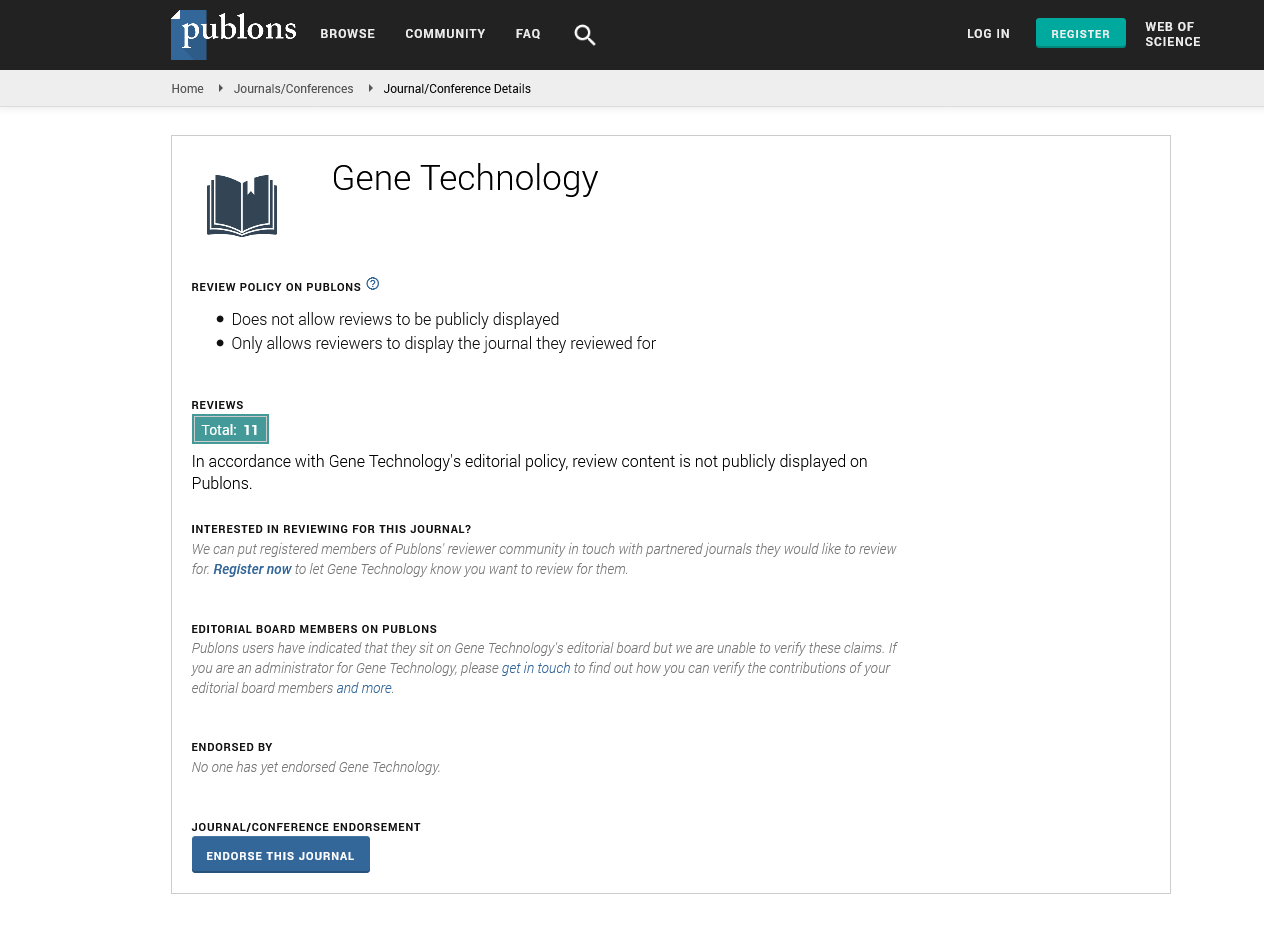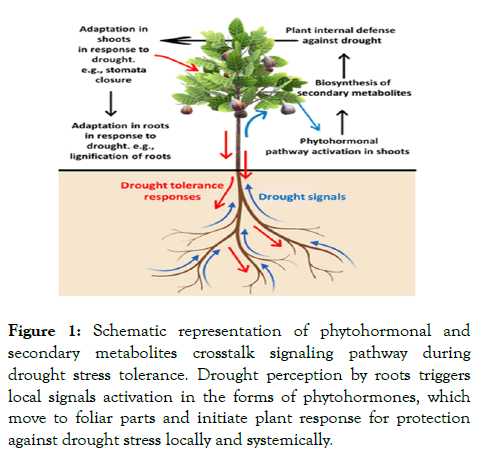Indexed In
- Academic Keys
- ResearchBible
- CiteFactor
- Access to Global Online Research in Agriculture (AGORA)
- RefSeek
- Hamdard University
- EBSCO A-Z
- OCLC- WorldCat
- Publons
- Euro Pub
- Google Scholar
Useful Links
Share This Page
Journal Flyer

Open Access Journals
- Agri and Aquaculture
- Biochemistry
- Bioinformatics & Systems Biology
- Business & Management
- Chemistry
- Clinical Sciences
- Engineering
- Food & Nutrition
- General Science
- Genetics & Molecular Biology
- Immunology & Microbiology
- Medical Sciences
- Neuroscience & Psychology
- Nursing & Health Care
- Pharmaceutical Sciences
Commentary - (2021) Volume 10, Issue 5
Commentary on Phytohormones Crosstalk with Secondary Metabolites in the Drought Stress Tolerance of Crop Plants
Om Prakash Narayan1* and Bindu Yadav22Department of Environmental Sciences, Jawaharlal Nehru University, New Delhi, India
Received: 24-Feb-2021 Published: 22-Oct-2021
Abstract
Plants evolved different regulatory pathways to regulate downstream plant responses to drought stress. Phytohormone signaling networks play a crucial role in activating defense molecules' biosynthesis like Secondary Metabolites (SMs) under drought stress. This crosstalk between phytohormones and SMs minimizes oxidative stress, excessive water loss, and other adverse effects of drought in plants. Further, drought-induced SMs alarms plant tissue to conquer defensive drought stress mitigating processes via systemic induction of drought signaling.
Keywords
Crop plants; Drought; Phytohormones; Secondary Metabolites
Introduction
Drought is significant abiotic stress that negatively influences plant growth and development and threatens global food security. Corp plants have evolved a complex defense system network to cope with various biotic and abiotic stresses. Phytohormonal networks and plant deference molecule from secondary metabolism play an important defense role in environmental stress along with other plant defense networks such as Ca2+ signaling, membrane stress sensor/receptors, MAP kinase signaling, ion channels, Reactive Oxygen Species (ROS), etc. [1,2]. Drought triggers the activation of downstream defense networks mainly via activation of phytohormones homeostasis and their signaling network. This hormonal signaling result in the biosynthesis of different types of protective Secondary Metabolites (SMs), which further provide multi-stress tolerance, including drought stress. During drought stress, the soil becomes dry, and drought stress is sense by plant roots as a stress signal through the cell to cell signaling network. Subsequently, these stress signals travel to above-ground tissue toward leaves through root to shoot signaling via xylem. Further, it results in the induction of systemic phytohormone signaling and biosynthesis of SMs [3]. The crosstalk with SMs mediated signaling and phytohormone mediated signaling triggers the stomatal closure to prevent the water loss through vascular to guard cell signaling. Several regulatory pathways work together to regulate the drought-induced downstream plant responses, which minimize excessive water loss and oxidative damages by scavenging ROS [4-6]. Altogether, a crosstalk interaction of phytohormones and SMs is essential for plant defense under drought stress. So, understanding the mechanism of crosstalk is vital to improve the plant defense system towards drought stress.
Have explored the in-depth crosstalk mechanism of phytochromes with SMs [4]. Authors have described about phytohormone action and response mechanism in drought stress in detail. They have also described the role of different phytohormones and SMs, their exogenous application, and pathways engineering to improve plants to resist drought stress. Altered induction or production of SMs is very much speciesspecific. The key hormone such as Jasmonic Acid (JA), Salicylic Acid (SA), Cytokinin (CK), and Auxins (AUX) play a crucial crosstalk interaction with SMs. So, brief crosstalk between important phytohormones and SMs are described here.
Literature Review
JA and SMs crosstalk under drought
JA is a key phytohormone that stimulates the biosynthesis of SMs under drought stress. It has been noticed that exogenous application of JA results in the induction of drought-responsive metabolites by activating antioxidant enzymes like APX, Dehydroascorbate Reductase (DHAR), γ-glutamyl cysteine synthetase, Glutathione Reductase (GR), and l-galactono-1,4- lactone dehydrogenase [7]. JA and MeJA together elicit the production of several SMs such as alkaloids, coumarins, taxanes, terpenoids, and phenolic phytoalexins in several plant species [1].
SA and SMs crosstalk under drought
It has shown that SA treatment under drought results in the induction of signal transduction pathway encoding gene for SMs and antioxidants. SA application in lemongrass results in the induction of biosynthesis of terpene citral in order to ameliorate drought stress, and SA application in chickpea results in elevated expression of PR-1 gene, which regulated drought stress [8-10]. Similarly, exogenous application of SA before drought induction results in the accumulation of several compounds such as phenolic compounds, protein, disaccharide, sugar, succinate, leucine, glyceric acid, and saccharic acid that protect the plant during drought stress [11]. Pretreatment of soybean seeds with SA improves the pectin and lignin content in the roots, helping the plant ameliorate drought stress [12]. Moreover, SA treatment results in the induction of the genes involved in the SMs biosynthesis. These include cinnamyl alcohol, sinapyl alcohol dehydrogenase, dehydrogenase, and cytochrome P450 [8].
CK and SMs crosstalk under drought
Under drought stress, CK treatment results in several metabolites' biosynthesis that helps the plant resist drought stress. For instance, the accumulation of various metabolites, such as proline, γ-aminobutyric acid, alanine, glycine, sucrose, fructose, maltose, ribose, and organic acids, was associated with enhanced drought tolerance in SAG12-IPT plants. These metabolites are involved in several stress response pathways, stress signaling, osmotic adjustment, and respiration for energy production, helping plants from drought stress [13]. Moreover, in barley, it was observed that ectopic overexpression of CKX has led to the activation of the biosynthesis of flavonoids, antioxidants, and stronger lignification of the root tissues [14,15].
Auxin and SMs crosstalk under drought
Auxins show a different level of crosstalk with SMs under drought stress. A mutational analysis revealed that auxin plays a role in UV acclimation by regulating flavonoid concentration [16]. During stress, AUX/IAA suppressor proteins such as IAA5, 6, and 19 control the biosynthesis of aliphatic GLs as well as stomatal closer. However, the triple mutant iaa5 iaa6 iaa19 compromised aliphatic GLs accumulation and stomatal closure under drought stress. Additionally, upregulation of DREB2A/B under drought stress increases the transcripts of IAA5, 6, and 19, thereby accumulating aliphatic GLs. The activation of IAA5, 6, and 19 induces the biosynthesis of aliphatic GLs by downregulating a transcription factor WRKY63. So, GLs have an additional role in promoting drought tolerance by crosstalk with auxins [17].
Discussion
The crosstalk between phytohormonal signaling and the biosynthesis pathways of SMs are pivotal in providing a sustainable solution for enduring drought stress in crop plants. So, an in-depth study on crosstalk signaling between phytohormones and SMs is highly required to make plants more drought resistant. A schematic representation of phytohormonal and SMs crosstalk signaling pathways during drought stress tolerance is given in Figure 1.
Figure 1: Schematic representation of phytohormonal and secondary metabolites crosstalk signaling pathway during drought stress tolerance. Drought perception by roots triggers local signals activation in the forms of phytohormones, which move to foliar parts and initiate plant response for protection against drought stress locally and systemically.
Conclusion
Drought is severe abiotic stress that has a negative impact on plant growth and development and poses a danger to global food security. It causes the activation of downstream defence networks, mostly through the activation of phytohormones. Further, pathways engineering of genes from phytohormone and SMs signaling could be a great approach to improve plant productivity under drought stress. Potent candidate genes for generating drought-resilient transgenic plants could be the future interest for the researchers.
Acknowledgments
We acknowledge the Council of Scientific and Industrial Research (CSIR), Jawaharlal Nehru University, New Delhi, India, and Tufts University, Boston, USA.
Author Contributions
OPN and BY have written and compiled the manuscript. OPN and BY have helped in editing the manuscript. OPN has conceptualized the theme of this review and edited the final manuscript. All authors finally read and approved the manuscript.
Data Availability Statement
Data sharing is not applicable to this article as no new data were created or analyzed in this study.
REFERENCES
- Akula R, Ravishankar GA. Influence of abiotic stress signals on secondary metabolites in plants. Plant Signal Behav. 2011;6(11):1720-31.
- Jogawat A. Crosstalk among phytohormone signaling pathways during abiotic stress. Molecular Plant Abiotic Stress: Biology and Biotechnology. 2019;12:209-20.
- Jogawat A, Yadav B, Lakra N, Singh AK, Narayan OP. Secondary metabolites in the drought stress tolerance of crop plants: A review. Gene Rep. 2021;172(2):1106-32.
- Jogawat A, Yadav B, Lakra N, Singh AK, Narayan OP. Crosstalk between phytohormones and secondary metabolites in the drought stress tolerance of crop plants: a review. Physiol Plant. 2021;172(2):1106-32.
- Yadav B, Jogawat A, Gnanasekaran P, Kumari P, Lakra N, Lal SK, et al. An overview of recent advancement in phytohormones-mediated stress management and drought tolerance in crop plants. Plant Gene. 2020;25:100264.
- Jogawat A, Yadav B, Narayan OP. Metal transporters in organelles and their roles in heavy metal transportation and sequestration mechanisms in plants. Physiol Plant. 2021;173(1):259-275.
- Shan C, Liang Z. Jasmonic acid regulates ascorbate and glutathione metabolism in Agropyron cristatum leaves under water stress. Plant Sci. 2010;178(2):130-9.
- Jumali SS, Said IM, Ismail I, Zainal Z. Genes induced by high concentration of salicylic acid in'Mitragyna speciosa'. Aust J Crop Sci. 2011;5(3):296-303.
- Idrees M, Khan MM, Aftab T, Naeem M, Hashmi N. Salicylic acid-induced physiological and biochemical changes in lemongrass varieties under water stress. J Plant Interact. 2010;5(4):293-303.
- Tiwari S, Lata C, Chauhan PS, Nautiyal CS. Pseudomonas putida attunes morphophysiological, biochemical and molecular responses in Cicer arietinum L. during drought stress and recovery. Plant Physiol Biochem. 2016;99:108-17.
- Khan N, Bano A, Babar MA. Metabolic and physiological changes induced by plant growth regulators and plant growth promoting rhizobacteria and their impact on drought tolerance in Cicer arietinum L. PloSone. 2019;14(3):e0213040.
- Al-Hakimi AM. Counteraction of drought stress on soybean plants by seed soaking in salicylic acid. Int J Bot. 2006;2(4):421-426.
- Merewitz EB, Du H, Yu W, Liu Y, Gianfagna T, Huang B. Elevated cytokinin content in ipt transgenic creeping bentgrass promotes drought tolerance through regulating metabolite accumulation. J Exp Bot. 2012;63(3):1315-28.
- Vojta P, Kokáš F, Husičková A, Grúz J, Bergougnoux V, Marchetti CF, et al. Whole transcriptome analysis of transgenic barley with altered cytokinin homeostasis and increased tolerance to drought stress. New Biotechnol. 2016;33(5):676-91.
- Nakabayashi R, Yonekura‐Sakakibara K, Urano K, Suzuki M, Yamada Y, Nishizawa T, et al. Enhancement of oxidative and drought tolerance in Arabidopsis by overaccumulation of antioxidant flavonoids. Plant J. 2014;77(3):367-79.
- Hectors K, van Oevelen S, Guisez Y, Prinsen E, Jansen MA. The phytohormone auxin is a component of the regulatory system that controls UV‐mediated accumulation of flavonoids and UV‐induced morphogenesis. Physiol Plant. 2019;145(4):594-603.
- Salehin M, Li B, Tang M, Katz E, Song L, Ecker JR, et al. Auxin-sensitive Aux/IAA proteins mediate drought tolerance in Arabidopsis by regulating glucosinolate levels. Nat Commun. 2019;10(1):1-9.
Citation: Narayan OP, Yadav B (2021) Commentary on Phytohormones Crosstalk with Secondary Metabolites in the Drought Stress Tolerance of Crop Plants. Gene Technol. 10: 175.
Copyright: © 2021 Narayan OP, et al. This is an open-access article distributed under the terms of the Creative Commons Attribution License, which permits unrestricted use, distribution, and reproduction in any medium, provided the original author and source are credited.


